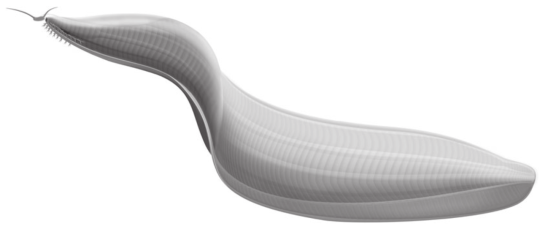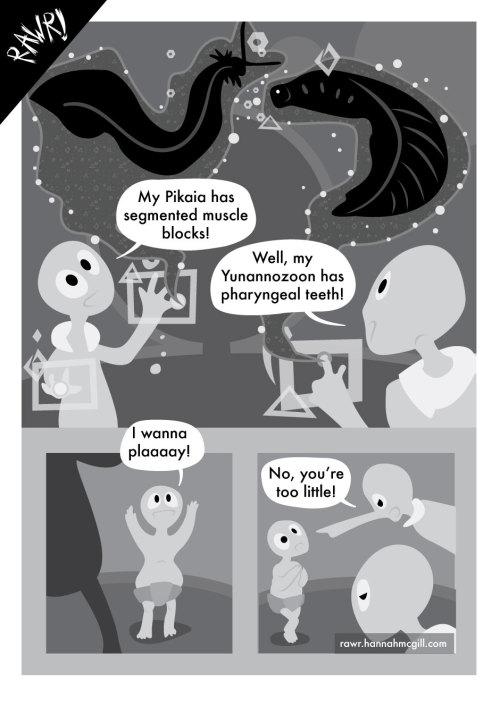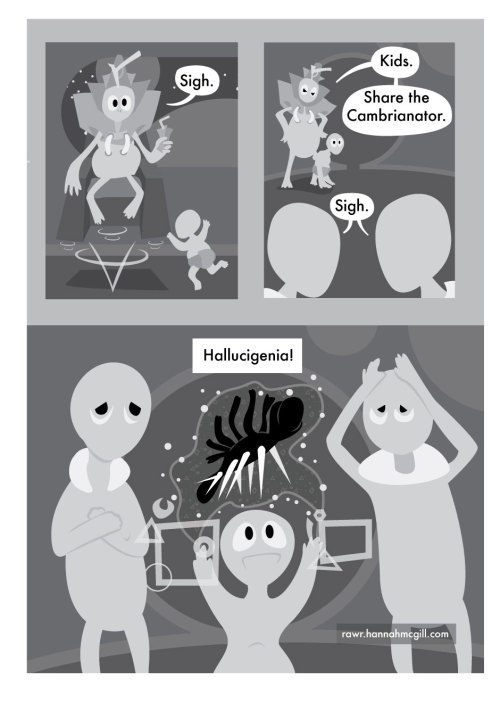#pikaia

Reconstruction by Marianne Collins, from Conway Morris and Caron 2012
Species:P. gracilens
Etymology: Derived from Pika Peak, a mountain near the type locality
Age and Location: Middle Cambrian of British Columbia
Classification:Metazoa: Eumetazoa: Bilateria: ?Deuterostomia: ?Chordata
Pikaia,despite its fame as the lancelet-like primitive chordate of the Burgess Shale and over a hundred known specimens, is a bizarre and poorly known creature. Due to the difficulty of interpreting its anatomy, it isn’t even clear if it’s a chordate at all; the only certain feature it shares with chordates is the presence of segmented muscle blocks known as myomeres. However, myomeres are also known in the seemingly non-chordate Myoscolex,which may be an annelid. Pikaiahas only a hint of a possible notochord, but it is impossible to tell from fossils if this structure is a notochord, blood vessel, nerve, or something else.
Pikaiawas a strange marine animal, known only from the Burgess Shale, where it was uncommon but not especially rare. Adult Pikaiawere on average around 4 cm long, with the largest individuals approaching 6 cm. Like most swimming chordates, it was laterally compressed; it swam by undulating its body like an eel. However, its muscles were relatively simple and Pikaiawas probably a poor swimmer that kept close to the seafloor.
Pikaiahad a pair of small sensory tentacles in front of its mouth that served as its primary sense organs. It was probably a selective feeder; its small mouth and limited ability to expel water through its tiny pharyngeal slits would have precluded suspension feeding, which is otherwise the norm in early deuterostomes. Next to its pharyngeal slits, it had tiny appendages that may have served as gills.
Pikaiahad several bizarre internal organs of unknown function; the most prominent of these was a thick “dorsal organ” running the length of its body. This structure, once incorrectly interpreted as a notochord, may have been internal cuticle that served to stiffen the body. Because of this and other oddities, it is unclear in what ways Pikaiamay relate to other chordates. It may be a perfect example of a transitional form between primitive deuterostomes and chordates, or it may be a strange side branch of chordate evolution–if it’s even a chordate at all.
Sources:
Conway Morris S., Caron JB. 2012. Pikaia gracilens Walcott, a stem-group chordate from the Middle Cambrian of British Columbia. Biological Reviews 87:480–512.
Dzik J. 2004. Anatomy and relationships of the Early Cambrian worm Myoscolex. Zoologica Scripta 33:57–69.
Lacalli T. 2012. The Middle Cambrian fossil Pikaia and the evolution of chordate swimming. EvoDevo 3:12.
Mallatt J., Holland N. 2013. Pikaia gracilens Walcott: Stem Chordate, or Already Specialized in the Cambrian. Journal of Experimental Zoology Part B: Molecular and Developmental Evolution 320:247–271.


